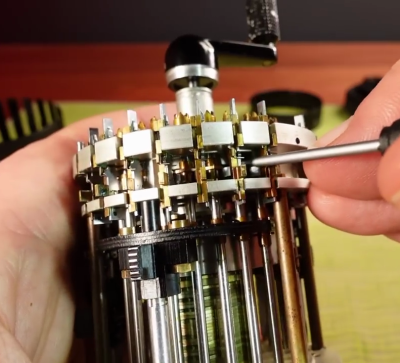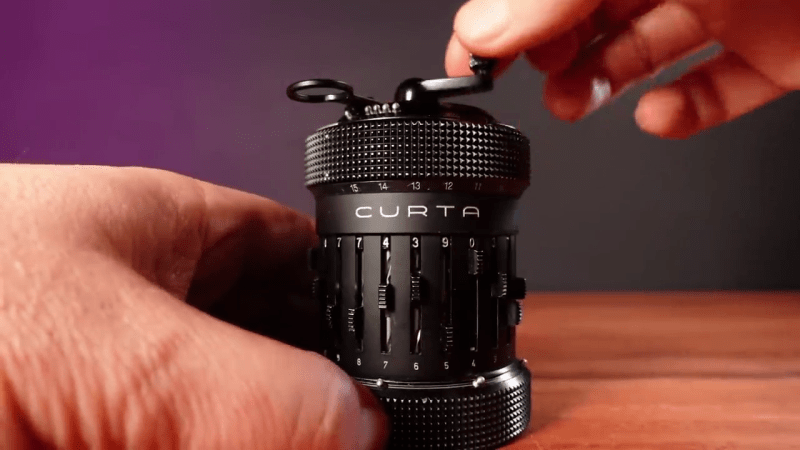We’ve always admired Curta mechanical calculators, and would be very hesitant to dismantle one. But [Janus Cycle] did just that — and succeeded. A friend sent him a Curta Model 2 calculator that was frozen up. Just opening the case involved percussive force to remove a retaining pin, and once inside he discovered the main shaft had been slightly bent. No doubt this calculator had suffered a drop at some point in the past.
I’m sticking to the rule of doing no harm — I’d rather not be able to fix this than do something that causes more problems.

But surprisingly, he was able to get it substantially back in working order without completely taking apart all 600+ parts. Most of the issues were shafts whose lubrication had become gummy, and one carry lever was slightly bent. There is still a little more work, but soon this calculator will once again be cranking out results.
Has anyone dismantled a mechanical contraption this complicated before, for example a teletype machine? Let us know in the comments. If you want to brush up on your Curta knowledge, check out the Curta Calculator Page. We also wrote a Retrotechtacular about the Curta before. Thanks to [mister35mm] for sending in this tip.

















That YouTube video had 100% of my attention. Thank You, David
And of-course: “42 is The Answer to the Ultimate Question of Life, the Universe, and Everything”.[1]
1. https://en.wikipedia.org/wiki/Phrases_from_The_Hitchhiker%27s_Guide_to_the_Galaxy#The_Answer_to_the_Ultimate_Question_of_Life,_the_Universe,_and_Everything_is_42
There’s also the 3D printed Curta if you can’t obtain an original.
3D Printed Curta Gets Upgrades
https://hackaday.com/2017/08/01/3d-printed-curta-gets-upgrades/
Curt Herzstark got the idea for building his pocket calculator while he was in Buchenwald concentration camp.
My thougths when I read the title: “AAAAAAAAAAAAAAAAAA NOOOOOOOOOOOOO”. Well, he managed to fix it. Pheu. I can sleep now.
For whom does not know, there’s an anectote that the Curtas were sold under the production price and if you were an idiot and disassembled your Curta, you’ll have to pay the remaining money to get it reassembled.
Wonderful machine. It replaced a calculating machine that took a quarter of a desk in space.
Like making a Bombe the size of a watch.
I wonder if he bent the main shaft when he hammered out that pin without supporting it…
Both hammering on the thing without supporting it and attacking it with scissors to remove cliprings does not exactly fall in the “do no harm” category for me. But it’s also easy to criticize youtubers from a distance. But still, I’m sure that clickspring guy would have done it differently.
I do wonder what he did with that bent short shaft. It looks like it would not survive straightening it and probably needs to be replaced completely.
Oh yes. After working on asr-33’s, t37’s, t100’s, model 15 and model14, olivetti 101,ncr cash register, monroe and friden calculatorsand lately a varityper 1010, i am still am amazed at the ingenuity of the designers. Deep respect here. I think a lot of that ingenuity has been lost and replaced by computers.
I think Friden was one of the last to switch to electronics. I once found the remains of an accounting desk, full of relais and an ibm model C as output device where the internal calculating part was an friden SRW, completely outfitted with solenoids and encoders to program it and read back the results. A mechanical cpu.
I repaired ASR-33s in college. A remarkable mechanical solution to the problem of receiving and printing serial data. I wouldn’t even try to work on a Curta.
I work under the theory that what can be devised by man, can be understood by man, and repaired by man. Still , you’d better know your onions, and have good mechanical skills and the right tools; the Curta is not for the faint of heart, hand, or head.
Unless the man chose to weld it shut and the only way to fix it is to make a new one.
You can grind off welds…..
And then you have to make them anew.
If you’ve been watching restoration videos on Youtube, sometimes they fix furniture or wooden parts that were originally put together by tab-slot joinery, wedges and nails, and they choose to glue them for good measure. The effect for the next guy who attempts to restore the piece is that the glued joints won’t come apart without breaking the wood, so they can’t disassemble the piece without breaking it and then making all new parts.
Thanks for the article. I didn’t even know the CURTA existed! What an intriguing device. I always marvel at the person that comes up with these mechanical marvels the ‘first’ time. Amazing engineering and insight!
Thank you for this excellent video. Great work on the close ups! Well done! The profession of watchmaker comes to mind for the skills and tools needed to service this mechanical calculator.
I owned a Curta that had a broken clearing ring. I got a reproduction of one off ebay and was able to replace it…except there is a spring “spider” that I managed to break. A friend who had experience fixing watches was able to silver solder it together and it worked fine after. The thing is made like a Swiss watch.
There is a full video of assembling one from scratch.
https://www.youtube.com/watch?v=AnTb26WHx2Q
Clearly a number of jigs and special tools involved, as well as special lubricants. The oils are likely similar to the ones used in watch repair; the YouTube channel https://www.youtube.com/@WristwatchRevival has many demonstration watch repair videos that could be useful.
The assembling video is interesting, but what a pitty that the original 4:3 video has been stretched to 16:9 ratio!!! This is visible from the very first seconds, where the logo symbolizing the Curta is displayed as an oval instead of a circle.
Have I ever disassembled an item this complicated?
Sure! A bunch of times actually!
Have I ever reassembled one afterwards?
No comment…
About 2008 I got chatting to another visitor at Bletchley Park – retired chap – that was surprisingly open about what he used to do.
He used to work for MI6 – not spying – but servicing and repairing their mechanical encryption machines (that they retained in use, I think, until the early 1980’s).
(at that time the MI6 HQ was, allegedly, a hotch-potch of little offices around Borough High St)
And if you think that mechanical calculator is complicated – you should have seen some of these mechanical encryption machines – from the size of. very large typewriter, down to smaller than a tobacco tin.
The smallest of them basically looked like a huge collection of mechanical watch parts – gears, cogs, levers, worm drives (I did notice a certain outwards similarity to the old Minox spy camera) – basically the whole box was nothing but mechanical moving parts, with virtually no space in-between, and the tiniest of teeth on every wheel.
I’ve wanted one of these since I read Pattern Recognition
Funny, a teletype machine as the height of mechanical complexity. How times have changed.
Repaired and maintained Teletypes for 2 Squadrons of Submarines in Connecticut back in the 1980’s. Clutches, levers, gears, springs, slides, cams, bails….oh yeah.
The class for maintaining a model 33 teletype was to take it all apart, oil it and put it back together in working order. Took 2 weeks at the teletype factory in suburban Chicago for the class a .million years ago. We used model 33s for the I/o console of a DG Nova 1200 minicomputer.
In the ’70s, I converted a Friden to speak RS-232 / UART. It was pretty much straight forward except having to detect “shifted” ASCII characters, hit the shift key, FIFO buffer the “shifted character” while waiting for the solenoids to lift the basket, and then drain the FIFO by having the Friden type slightly faster than the UART. The problem was lifting the heavy basket drained the power supply and too many shifts in a row would cause the shift mechanism to jam.
Spent ’76 and ’77 completely tearing down asr33’s and 35’s including 7 and 9 channel paper tape readers and punches, cleaning in Varsol and tri, reassembling, tuning, testing, took about 3 days or so per machine if lucky. Lot of hands on tricks. If you followed the factory repair manual it would never work! Worked for Digital in MA, USA. VT series and other dumb terminals replaced the teletypes. I still have the bend adjust tools. One of the hardest things I ever worked on other than ebeam lithography tools.
I have one I might want to sell
Brettman0055@gmail.com
If anyone is interested
I still have my Type II that I bought around 1966 or ’67 for sports car rallyes. I used it soon after to “augment” my slide rule as an engineering student. It’s a mechanical marvel and still works as good as when new. Thanks for the video.
For more than 13 years I have been researching and documenting the Curta in all its variations and in various topics – to be seen at https://curta.li/
Partly I also repair (own) Curtas – here a small documentation in 30 pictures:
https://curta.li/02_type2/72_zehntausendste_01.html
Greetings from Switzerland